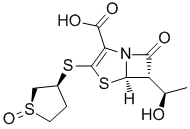Sulopenem (CP-70429, CP 70429, CP70429) is a penem-based antibiotic isolated from Penicillium and acts as a β-lactamase inhibitor with a broad spectrum of antibacterial activity against gram-positive and gram-negative bacteria except Pseudomonas aeruginosa and Xanthomonas maltophilia.
Physicochemical Properties
| Molecular Formula | C12H15NO5S3 |
| Molecular Weight | 349.434 |
| Exact Mass | 349.011 |
| Elemental Analysis | C, 41.25; H, 4.33; N, 4.01; O, 22.89; S, 27.52 |
| CAS # | 120788-07-0 |
| Related CAS # | 112294-81-2 (sodium);120788-07-0; |
| PubChem CID | 9950244 |
| Appearance | White to yellow solid powder |
| Density | 1.74g/cm3 |
| Boiling Point | 693.1ºC at 760mmHg |
| Flash Point | 373ºC |
| Vapour Pressure | 3.2E-22mmHg at 25°C |
| Index of Refraction | 1.768 |
| LogP | 1.21 |
| Hydrogen Bond Donor Count | 2 |
| Hydrogen Bond Acceptor Count | 8 |
| Rotatable Bond Count | 4 |
| Heavy Atom Count | 21 |
| Complexity | 563 |
| Defined Atom Stereocenter Count | 5 |
| SMILES | O=S1CCC(SC2SC3C(C(=O)N3C=2C(=O)O)C(O)C)C1 |
| InChi Key | FLSUCZWOEMTFAQ-IIOOQZKLSA-N |
| InChi Code | InChI=1S/C12H15NO5S3/c1-5(14)7-9(15)13-8(11(16)17)12(20-10(7)13)19-6-2-3-21(18)4-6/h5-7,10,14H,2-4H2,1H3,(H,16,17)/t5-,6+,7+,10-,21?/m1/s1 |
| Chemical Name | (5R,6S)-6-((R)-1-hydroxyethyl)-3-(((3S)-1-oxidotetrahydrothiophen-3-yl)thio)-7-oxo-4-thia-1-azabicyclo[3.2.0]hept-2-ene-2-carboxylic acid |
| Synonyms | CP-70,429; CP 70,429; CP70,429; CP-70429; CP 70429; CP70429; Sulopenem. |
| HS Tariff Code | 2934.99.9001 |
| Storage |
Powder-20°C 3 years 4°C 2 years In solvent -80°C 6 months -20°C 1 month |
| Shipping Condition | Room temperature (This product is stable at ambient temperature for a few days during ordinary shipping and time spent in Customs) |
Biological Activity
| Targets |
|
|
| ln Vitro |
Sulopenem may be used to treat both simple and complex urinary tract infections as well as intra-abdominal infections, including those that are multidrug-resistant (MDR) and those caused by Gram-negative bacteria that produce extended-spectrum β-lactamase (ESBL) and are not susceptible to quinolones[1]. At a concentration of ≤1 μg/mL, sulopenem inhibits the growth of the majority of isolates of aerobic and anaerobic Gram-positive and Gram-negative bacteria, including methicillin-susceptible Staphylococcus aureus, Streptococcus pneumoniae (penicillin-susceptible and -resistant isolates), group A and B β-hemolytic streptococci, Listeria monocytogenes, Enterobacteriaceae, Haemophilus influenzae, and Moraxella catarrhalis, but not P. aeruginosa and Stenotrophomonas maltophilia[1]. |
|
| ln Vivo | In experimental systemic infections in mice, Sulopenem has better protective effects than Imipenem/Cilastatin. Sulopenem has a lower ED50 in an experimental mixed infection of Escherichia coli and Bacteroides fragilis in mice. Sulopenem is more effective than CZON or Cefotiam in treating experimental lung infections caused by Klebsiella pneumoniae in guinea pigs[3]. | |
| References |
[1]. In Vitro Activity of Sulopenem, an Oral Penem, Against Urinary Isolates of Escherichia coli. Antimicrob Agents Chemother. 2018 Dec 21;63(1):e01832-18. [2]. In Vitro Antibacterial Activity and Beta-Lactamase Stability of CP-70,429 a New Penem Antibiotic. Antimicrob Agents Chemother. 1993 Jul;37(7):1547-51. [3]. In Vitro and in Vivo Activities of Sulopenem Compared With Those of Imipenem and Cephalosporins. Jpn J Antibiot. 1996 Apr;49(4):303-23. |
|
| Additional Infomation |
Sulopenem is under investigation in clinical trial NCT03357614 (Sulopenem Followed by Sulopenem-etzadroxil/Probenecid vs Ertapenem Followed by Cipro for Complicated UTI in Adults). Sulopenem is a parenteral thiopenem with broad-spectrum antibacterial activity against most gram-positive and gram-negative bacteria. Sulopenem is not active against Pseudomonas aeruginosa. In addition, this agent is fairly stable against hydrolysis by various beta-lactamases. |
Solubility Data
| Solubility (In Vitro) | DMSO : ~83.33 mg/mL (~238.46 mM) |
| Solubility (In Vivo) |
Solubility in Formulation 1: ≥ 2.08 mg/mL (5.95 mM) (saturation unknown) in 10% DMSO + 90% (20% SBE-β-CD in Saline) (add these co-solvents sequentially from left to right, and one by one), clear solution. For example, if 1 mL of working solution is to be prepared, you can add 100 μL of 20.8 mg/mL clear DMSO stock solution to 900 μL of 20% SBE-β-CD physiological saline solution and mix evenly. Preparation of 20% SBE-β-CD in Saline (4°C,1 week): Dissolve 2 g SBE-β-CD in 10 mL saline to obtain a clear solution. Solubility in Formulation 2: (Please use freshly prepared in vivo formulations for optimal results.) |
| Preparing Stock Solutions | 1 mg | 5 mg | 10 mg | |
| 1 mM | 2.8618 mL | 14.3090 mL | 28.6180 mL | |
| 5 mM | 0.5724 mL | 2.8618 mL | 5.7236 mL | |
| 10 mM | 0.2862 mL | 1.4309 mL | 2.8618 mL |
